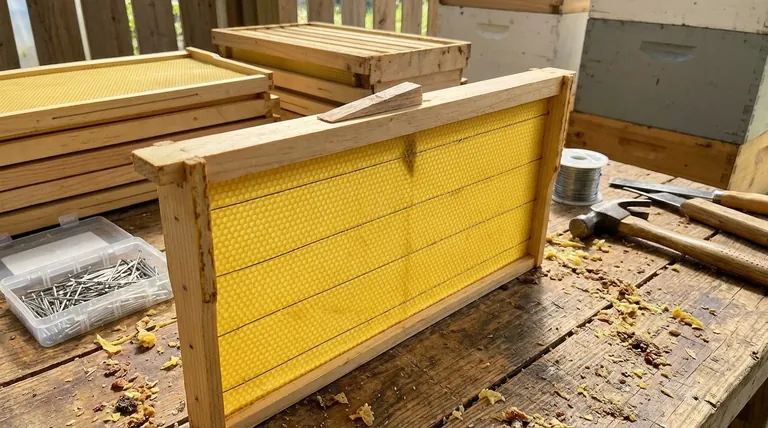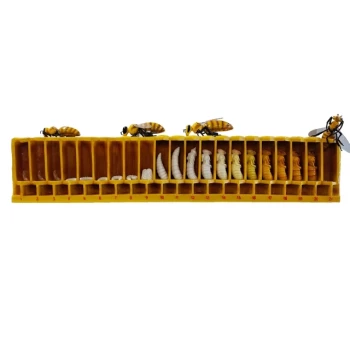Securing beeswax foundation correctly is a critical step in preparing beekeeping equipment. In wooden frames, foundation is held in place using either small metal support pins or, more robustly, by embedding the wax onto horizontal wires that run across the frame. The top edge of the foundation is almost always clamped into the top bar of the frame using a removable wooden strip called a wedge.
The method you choose to secure your foundation is not just about attachment—it's about providing the structural integrity the comb will need to withstand the heat of the hive and the intense forces of honey extraction.

Why Proper Foundation Support is Crucial
A simple sheet of beeswax foundation is fragile. Without proper support, it will fail, creating significant problems within the hive and for the beekeeper.
Prevents Sagging and Warping
A beehive is a warm, humid environment. Without support, a sheet of beeswax will soften, sag, and warp under its own weight, especially once bees begin adding more wax and weight to it.
Ensures Straight Comb for Easy Inspection
Unsupported foundation can lead bees to build "cross comb," where they connect the comb to an adjacent frame. This makes it impossible to remove a single frame for inspection without destroying the comb and agitating the hive.
Provides Strength for Honey Extraction
This is the most critical reason for proper support. Honey extractors use centrifugal force to spin honey out of the comb. An unsupported or weakly supported comb will disintegrate under these forces, resulting in a loss of honey and drawn comb.
Two Core Methods for Securing Foundation
While the goal is the same—a strong, straight comb—the two primary methods offer different levels of support and effort.
Method 1: Support Pins (Simple & Fast)
Support pins are small, sharp metal pins pushed through the side-bar holes of a frame. Typically, two to four pins are used per side to hold the wax sheet in place.
This method is quick and requires no special tools. The pins provide enough support to prevent sagging and encourage straight comb construction.
Method 2: Wiring (Maximum Strength)
Wiring is the professional standard, especially for frames intended for honey collection (supers). This involves running thin, horizontal wires through the holes in the frame's side bars.
Once the wires are installed and tensioned, the wax foundation is laid on top. An embedder—a tool that passes a low-voltage electric current through the wires—is used to heat the wires just enough to melt them into the foundation, creating a single, incredibly strong unit.
The Role of the Wedge Bar
Nearly all wooden frames feature a wedge bar, a removable wooden strip on the underside of the top bar. You insert the top edge of the foundation sheet into the groove, then nail the wedge bar back in place, securely clamping the foundation. This step is used with both pins and wires.
Understanding the Trade-offs
Choosing the right method depends on the frame's intended use and how much time you are willing to invest.
Support Pins: Speed vs. Durability
Support pins are ideal for frames in the brood chamber. The comb here is primarily for raising young bees and is not typically put through an extractor. The speed and simplicity of this method are its main advantages. However, it is not recommended for honey supers.
Wiring: Effort vs. Longevity
Wiring a frame takes more time and requires tools like a wire embedder. However, the resulting comb is extremely durable. It can withstand high-speed extraction and will last for many years, making the initial time investment worthwhile for any serious honey production.
A Note on Pre-Wired Foundation
You can also purchase foundation with vertical wires already embedded by the manufacturer. These sheets often have small wire hooks at the top that are secured by the wedge bar. While this adds strength, you must still provide horizontal support with either pins or, preferably, additional horizontal wiring for use in an extractor.
Making the Right Choice for Your Goal
Select your method based on what you want to achieve with the frame.
- If your primary focus is the brood chamber: Support pins offer a fast and effective solution for comb that won't be put through an extractor.
- If your primary focus is honey supers: Wiring your frames is non-negotiable for creating comb that can withstand the forces of honey extraction.
- If you want a balance of convenience and strength: Use pre-wired foundation and add horizontal wires for a robust setup that is slightly faster than wiring plain foundation.
Properly supporting your foundation is a direct investment in the long-term health of your hive and the efficiency of your harvest.
Summary Table:
| Method | Best For | Key Feature |
|---|---|---|
| Support Pins | Brood Chambers | Fast, simple installation |
| Wiring | Honey Supers | Maximum strength for extraction |
| Wedge Bar | All Frames | Secures the top edge of the foundation |
Build a stronger, more productive apiary with HONESTBEE.
As a trusted supplier for commercial apiaries and beekeeping equipment distributors, we provide the high-quality, durable frames and foundation supplies you need for a successful operation. Our wholesale-focused operations ensure you get the right equipment to maximize hive health and honey production.
Let our experts help you select the best foundation and frames for your specific needs. Contact HONESTBEE today to discuss your wholesale requirements!
Visual Guide

Related Products
- Notebook Style Beeswax Foundation Mould Wax Foundation Mold
- Manual Beeswax Comb Foundation Machine Wax Foundation Mill Embossing Machine
- Electric Beeswax Foundation Machine With Operating Tray and Wax Foundation Roller
- Electric Beeswax Flat Sheet Machine with Operating Tray for Wax Processing
- Economy Manual Beeswax Embossing Mill Wax Foundation Machine Roller
People Also Ask
- How do you store beeswax foundation? Prevent Wax Moth Damage and Preserve Quality
- How do you use the Foundation Mold to create beeswax foundation? Master DIY Beekeeping with Precision
- What is the process for making beeswax sheets using a mold? A Step-by-Step Guide for Perfect Results
- What is required when using wax foundation in beekeeping frames? Essential Support for Strong Combs
- What is beeswax foundation made of? A Guide to Stronger, More Efficient Hives



















